<!--[if gte mso 9]>
Normal 0 false false false false EN-US X-NONE X-NONE <![endif]-->
It’s “yellow time.” October has arrived! Soon the leaves around here will turn golden and red and orange…and swirl down from trees in an autumn breeze. How I love this time of year. Today, I have two poems about autumn leaves…and reviews of three picture books on the same subject.***************
Here is an autumn leaves poem that I wrote many years ago:
AUTUMN CELEBRATION
In October, colored leaves
Fall from oak and maple trees—
Bright confetti shaken down
From their boughs. All over town
Trees are celebrating fall,
Decorating every wall,
Sidewalk, yard, and flowerbed
With pumpkin-orange, gold, and red.
We stand out in the falling leaves
And catch confetti on our sleeves,
In our hands and in our hair.
We party till the trees are bare.
AUTUMN LEAVES
By Eve Merriam
Down
down
down
Red
yellow
brown
Autumn leaves tumble down,
Autumn leaves crumble down,
Autumn leaves bumble down,
Flaking and shaking,
Tumbledown leaves.
Click here to read the rest of the poem. YELLOW TIME
Written & illustrated by Lauren Stringer
Beach Lane Books, 2016
I have been an admirer of Lauren Stringer’s picture book art for years. I love how she captured the essence of a snowy day and evening in Cynthia Rylant’s SNOW (Harcourt, 2008) and the warmth and coziness of time spent indoors on a cold winter day and night in her book WINTER IS THE WARMEST SEASON (Harcourt, 2006).
In her newest book, YELLOW TIME, Stringer gives readers a colorful glimpse of “falling leaves” time of year. Stringer said that she first experienced “yellow time” when she moved from New York City to Minneapolis. She said the view of ash trees through her window “was suddenly transformed by a huge gust of wind into a rain of leaves that covered everything and turned the world yellow.” Stringer beautifully captures that experience through a childhood perspective. Many of the book’s illustrations are saturated with yellow. She uses soft, curving shapes to depict tree tops, boughs and tree trunks bending in the wind, the movements of children delighting in the fluttering and swirling and whooshing of leaves borne through the air on an autumn wind. Stringer’s text is spare. She uses her art to illuminate what “yellow time” is all about. It is a true celebration of that wondrous time of year that passes all too quickly. Her book is a “symphony of yellow.”
FLETCHER AND THE FALLING LEAVES
Written by Julia Rawlinson
Illustrated by Tiphanie Beeke
Greenwillow, 2006
It’s autumn. Fletcher, a young fox, notices that the world around him is changing. Every morning things seem “just a little bit different.”
The rich green of the forest was turning to a dusty gold, and the soft, swishing
sound of summer was fading to a crinkly whisper.
Fletcher becomes worried when his favorite tree begins to look dry and brown. He thinks the tree is sick and expresses concern to his mother. His mother explains that it’s
“only autumn” and not to worry. Fletcher runs outside, pats his tree, and tells it that it will feel better soon.
Of course, the leaves on the tree continue to turn brown and fall from the branches. Fletcher catches a falling leaf and reattaches it to his tree--but the wind shakes the leaf loose again.
The next day, a strong wind blows through the forest, and the tree’s leaves are set flying. Fletcher’s upset when he sees a squirrel taking leaves for its nest and a porcupine using the fallen leaves to keep itself warm. Try as he might, Fletcher cannot save his tree from the inevitable. Finally, he clutches the last leaf as it flutters from the tree and takes it home--where he tucks it into a little bed of its own.
The following morning, Fletcher is awed by the sight of his tree, which is now hung with thousands of icicles shimmering in the early morning light. He wonders, though, if the tree is okay and asks:
“But are you all right?” Fletcher is relieved when a breeze shivers the branches and the tree makes
“a sound like laughter…” The little fox then hugs his tree and returns to his den for a
“nice, warm breakfast.”
Fletcher and the Falling Leaveshas a longer, more lyrical text than
Oliver Finds His Way.
Beeke’s soft-edged pastel illustrations capture the tone and setting of this comforting story and deftly convey the change of seasons as autumn turns to winter.
THE LITTLE YELLOW LEAF
Written & illustrated by Carin Berger
Greenwillow, 2008
Carin Berger, who did the “bold” and brilliant collage illustrations for Jack
Prelutsky’s
Behold the Bold Umbrellaphant, hits a high note again with her art in
The Little Yellow Leaf. Her illustrations in this book are inventive and striking. Berger even used composition and graph paper as the backdrop for some of her pictures. Her spare illustrations with changing perspectives and her lovely lyrical text partner well in this tale about finding strength in friendship.
The main character of this little allegory is a “Little Yellow Leaf.” It’s autumn. The
LYL clings to a branch of
“a great oak tree.” “I’m not ready yet, thought the Little Yellow Leaf as a riot of fiery leaves chased and swirled round the tree.” No, the leaf
isn’t ready to leave its home in the tree--even as the afternoon sun beckons--even…
as apples grew musky,
pumpkins heavy,
and flocks of geese
took wing.Even when
LYL sees that the other leaves have
“gathered into heaps, crackly dry, where children played,” it
isn’t willing to join them. And it still it
isn’t ready to leave its home when a harvest moon blooms in an
“amber” sky.
LYL holds fast to its branch through a long, cold night when snow falls. It holds fast as days pass. It looks and looks at the tree--but sees only the
“shimmer of snow.” LYL is all alone. At least that’s what it thinks…until one day it spies a
“scarlet flash” high up in the tree. It has a comrade! Both had been hesitant to cast off for the unknown. The Little Yellow Leaf and the Scarlet Leaf take courage in each other…set themselves free and soar.
Into the waiting wind they danced…
off and away and away and away.
Together.***************
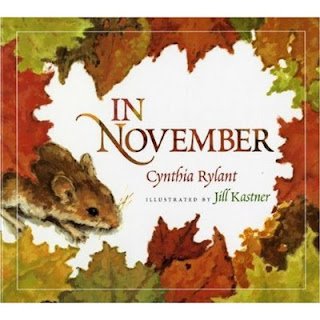 In November
In November
Written by Cynthia Rylant
Illustrated by Jill Kastner
Voyager/Harcourt, 2000
In November has a spare, lyrical text. It is not a storybook. It’s like a book-length prose poem that speaks to the essence of a month when the colorful beauty and fruitful bounty of the fall season is in the past. In the book, Rylant talks about snow blanketing the ground, trees that have lost their leaves, birds moving away for winter, animals sleeping more, food having an “orange smell” and tasting better, and people coming together to share a special holiday with each other. Rylant repeats the phrase “In November” several times in her text. This use of repetition throughout the book is one of the author’s writing techniques—along with the rhythm and flow of her evocative language—that helps her text read like poetry.
Here are some excerpts from the book to give you the “autumnal” flavor of In November:
In November, the trees are standing all sticks and bones. Without their leaves, how lovely they are, spreading their arms like dancers. They know it is time to be still.
In November, animals sleep more. The air is chilly and they shiver.
Cats pile up in the corners of barns.
Mice pile up under logs. Bees pile up in deep, earthy holes.
And dogs lie before the fire.
The book closes with my favorite passage:
In November, at winter’s gate, the stars are brittle. The sun is a sometime friend. And the world has tucked her children in, with a kiss on their heads, till spring.
Kastern’s full-color illustrations done in oil paints are as evocative of the month as are Rylant’s words. The uncluttered illustrations with changing perspectives and close-ups of leaves and birds and other animals draw a reader into the quiet text…into a “chilling” time of year when people and many animals draw into closer confines to keep themselves warm and to shelter themselves from the cold and long hours of darkness.
What Do You Do with a Book Like This?
Write a Collaborative Class Prose Poem
In November would be a great book to read aloud in the early elementary grades at this time of year—a book that could serve as a springboard for a creative writing exercise. So often children are asked to write about the signs of fall…but usually during an earlier part of the season when pumpkins and apples are growing plump and round in garden patches and orchards and trees are wearing leafy crowns of bright autumnal colors—or, in November, they’re asked to write about all the things they are thankful for as the Thanksgiving holiday approaches.
Why not lead students in writing a collaborative “In November” prose poem modeled after Rylant’s
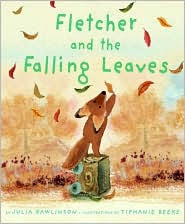
BOOK LISTS
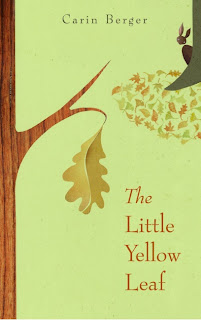
Here are links to some of my previous posts at
Wild Rose Reader for those of you interested in autumn leaf crafts and picture books and poetry books about autumn and autumn leaves:
Autumn Book Bunch: Leaves, Leaves Leaves!Here you’ll find reviews of three picture books I highly recommend for reading to young children during the fall season:
Oliver Finds His Way,
Fletcher and the Falling Leaves, and
The Little Yellow Leaf. Look What I Did with a Leaf!
Look What I Did with a Leaf!Here you’ll find a review of the nonfiction book
Look What I Did with a Leaf!, which includes ideas and instructions for creating leaf animal collages. I used this book as a springboard for a cross curricular/collaborative art project I did with our art teacher when I taught second grade.
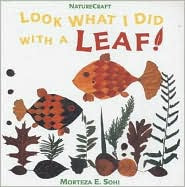 Fall into Poetry
Fall into PoetryHere you will find reviews of
Dappled Apples, a picture book written in verse and three poetry collections--
Autumnblings,
Autumn: An Alphabet Acrostic, and
A Chill in the Air: Nature Poems for Fall and Winter.
 Browse Inside Douglas Florian’s Autumnblings
Browse Inside Douglas Florian’s Autumnblings (
HarperCollins Web site)
 Autumn Leaf Crafts & Activities
Autumn Leaf Crafts & Activities
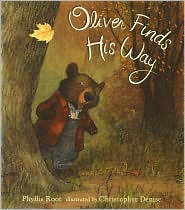 OLIVER FINDS HIS WAY
OLIVER FINDS HIS WAY
Written by Phyllis Root
Illustrated by Christopher DeniseCandlewick Press, 2002 is an exceptional picture book for students in preschool and kindergarten. Phyllis Root’s simple storyline about a little bear who finds himself lost near the edge of the woods, panics, and then thinks of a way to solve his problem, will resonate with young children. Christopher Denise’s illustrations, done in pastels and charcoal, provide a soft autumnal backdrop for Root’s spare text. They capture the flavor of the season and closeness of this loving “bear” family.
One fall day, while his parents are doing chores outside, Oliver chases an autumn leaf that is blown by the wind. He follows the big yellow leaf…
down the hill,
around a clumpy bush,
under a tree,
and all the way
to the end of the woods.Soon enough, Oliver discovers that he is lost. He tries to find his way back home--but the tree he runs to is not the twisty one he had passed before and the bush he runs to is not the clumpy bush he had seen earlier. Oliver’s afraid. He begins to cry…and cry….and cry. But he soon realizes that he’s still lost. He rubs his nose and thinks until he gets an idea. Then he roars and roars and roars--louder and
louder and
louder--until he hears Mama and Papa roaring back. Oliver is then able to listen to their roars and find his way home.
Note: When I was an elementary librarian, I used the art in
Oliver Finds His Way to introduce my youngest students to the concept of setting in picture books. The children could tell just from looking at the endpapers that the story was set out in the country in autumn. Click
here to view an illustration from the book.

FLETCHER AND THE FALLING LEAVES
Written by Julia Rawlinson
Illustrated by Tiphanie Beeke
Greenwillow, 2006
It’s autumn. Fletcher, a young fox, notices that the world around him is changing. Every morning things seem “just a little bit different.”
The rich green of the forest was turning to a dusty gold, and the soft, swishing
sound of summer was fading to a crinkly whisper.
Fletcher becomes worried when his favorite tree begins to look dry and brown. He thinks the tree is sick and expresses concern to his mother. His mother explains that it’s “only autumn” and not to worry. Fletcher runs outside, pats his tree, and tells it that it will feel better soon.
Of course, the leaves on the tree continue to turn brown and fall from the branches. Fletcher catches a falling leaf and reattaches it to his tree--but the wind shakes the leaf loose again.
The next day, a strong wind blows through the forest, and the tree’s leaves are set flying. Fletcher’s upset when he sees a squirrel taking leaves for its nest and a porcupine using the fallen leaves to keep itself warm. Try as he might, Fletcher cannot save his tree from the inevitable. Finally, he clutches the last leaf as it flutters from the tree and takes it home--where he tucks it into a little bed of its own.
The following morning, Fletcher is awed by the sight of his tree, which is now hung with thousands of icicles shimmering in the early morning light. He wonders, though, if the tree is okay and asks: “But are you all right?” Fletcher is relieved when a breeze shivers the branches and the tree makes “a sound like laughter…” The little fox then hugs his tree and returns to his den for a “nice, warm breakfast.”
Fletcher and the Falling Leaves has a longer, more lyrical text than Oliver Finds His Way. Beeke’s soft-edged pastel illustrations capture the tone and setting of this comforting story and deftly convey the change of seasons as autumn turns to winter.

THE LITTLE YELLOW LEAF
Written & illustrated by Carin Berger
Greenwillow, 2008
Carin Berger, who did the “bold” and brilliant collage illustrations for Jack Prelutsky’s Behold the Bold Umbrellaphant, hits a high note again with her art in The Little Yellow Leaf. Her illustrations in this book are inventive and striking. Berger even used composition and graph paper as the backdrop for some of her pictures. Her spare illustrations with changing perspectives and her lovely lyrical text partner well in this tale about finding strength in friendship.
The main character of this little allegory is a “Little Yellow Leaf.” It’s autumn. The LYL clings to a branch of “a great oak tree.” “I’m not ready yet, thought the Little Yellow Leaf as a riot of fiery leaves chased and swirled round the tree.” No, the leaf isn’t ready to leave its home in the tree--even as the afternoon sun beckons--even…
as apples grew musky,
pumpkins heavy,
and flocks of geese
took wing.
Even when LYL sees that the other leaves have “gathered into heaps, crackly dry, where children played,” it isn’t willing to join them. And it still it isn’t ready to leave its home when a harvest moon blooms in an “amber” sky.
LYL holds fast to its branch through a long, cold night when snow falls. It holds fast as days pass. It looks and looks at the tree--but sees only the “shimmer of snow.” LYL is all alone. At least that’s what it thinks…until one day it spies a “scarlet flash” high up in the tree. It has a comrade! Both had been hesitant to cast off for the unknown. The Little Yellow Leaf and the Scarlet Leaf take courage in each other…set themselves free and soar.
Into the waiting wind they danced…
off and away and away and away.
Together.
I highly recommend these three titles, which will make fine autumn read-alouds.






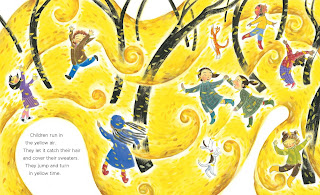











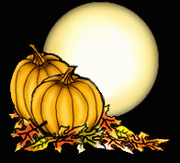



Great idea! I could do that with my own kids. Sounds like a beautiful book.
Thank you for this! My mom is a 5th grade teacher, and I'm going to send her the link to this post!
This looks gorgeous! Will have to check it out.
Rebecca,
I'm glad you like my idea. I did a similar writing activity with my second grade students using Rylant's book WHEN I WAS YOUNG IN THE MOUNTAINS. My students just changed Rylant's repetitive phrase and wrote individual books about their own lives--or one special event in their lives.
Kate,
I hope your mother likes my suggestion for writing a collaborative class prose poem.
Laura,
I'm sure you'll like Rylant's book.